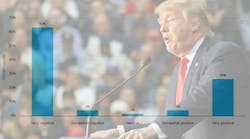San Diego, CA, a growing and scenic city, has little rainfall. Infrequent rains wash waste materials from the street, including automotive fluids, brake dust, leaves, grass clippings, pet waste, cigarette butts, mop water, and dirt. Storm drains carry it all away, but the drains aren’t connected to the city’s sanitary sewer system. Flowing along with the seen is the unseen. A cocktail of hydrocarbons, bacteria, and metals continue on to surface water bodies–eventually ending up in the bay and ocean.
Environmental watchdog groups like Think Blue, the Surfrider Foundation, and the Sierra Club sponsor cleanup days to create a broad awareness of environmental concerns. Some participants learn how to sample and test water bodies to see which locations are impaired.
The EPA has an extensive and increasing list of impaired water bodies within the US, notes Stewart McClure, president of Clearwater Solutions in Vista, CA. “Such waters need extra cleanup when followed by the legal introduction of total maximum daily loads [TMDLs] of certain constituents allowed to enter the water. Watchdog groups, especially in the San Diego area, ensure everyone stays in compliance. Certain states now are much more proactive and currently drive federal legislation on this issue.” Regarding the National Pollutant Discharge Elimination System (NPDES) stormwater rule, McClure says, “They make the rules slightly tougher every time. In many cases the states or municipalities taking out the permit from the federal government write stricter rules.”
McClure believes one answer to cleaning up the impaired water bodies lies in filtering stormwater runoff from streets before it hits the storm drain system. He helped develop a new stainless steel curb inlet filter device called the ClearWater BMP. This patent-pending filter allows for screening, settling, and filtering of stormwater runoff within an existing curb inlet drain box for a fraction of the cost of other filter units: $3,500, as opposed to $25,000 for installation for some systems for a new three-house area development. “San Diego County has now started to mandate using only filtering systems in new construction projects; hanging trash baskets are no longer acceptable. Competing filter units have a larger footprint, including specialized vaults involving some excavation work, which makes them more expensive,” says McClure.
Most collection systems catch debris and sediment. Sediment, McClure says, absorbs some hydrocarbons and heavy metals. Though sediment collects a percentage of pollution within stormwater runoff, it does not do much collecting of substances in solution. These substances bypass the sediment in collection systems, continuing into streams, rivers, lakes, bays, and the ocean.
Researchers in the Department of Civil and Environmental Engineering at San Diego State University (SDSU) tested a one-quarter-sized prototype of the ClearWater BMP in 2003. Dr. Badri Badriyha, an assistant professor in the department, has been involved with the study of the system. Badriyha was interested in real-world testing in curb inlets. Installation at an SDSU curb inlet took place in October 2005, but San Diego’s sporadic rainfall meant waiting until January 2006 for results, when two rainfalls occurred. Another two rainfalls occurred in February, followed by three in March. Sampling at the curb inlet occurred before and after the system’s installation.
“We compared performance of the unit based on stormwater samples taken before and after the unit. Also, we tweaked the units to test other capabilities and experimented with different filters to test modifications for removing specific pollutants, including metals, bacteria, and other microorganisms,” says Badriyha.
The ClearWater BMP consists of settling chambers and filters. It contains a catchment area for removing trash, sediment, leaves, and twigs. “As a result of our tests, we found that the system was very efficient in removing sediments and debris: in the range of 70% to 90% of the sediment,” says Badriyha. San Diego State University is also experimenting with specialized filters for removal of bacteria and other microorganisms.
Badriyha is involved in other stormwater projects aimed at removing metals from dismantlers. His group has a grant from the San Diego Foundation, which is funding part of the research being conducted on the ClearWater BMP technology. “Part of our work involving the San Diego Foundation is developing filters for specific metal removal,” says Badriyha. “Those filters will be used in the system also. Once installed in the units, the metal removal will be very high. These units are very versatile for use all over the country. They don’t require extensive retrofitting and can be placed in virtually any curb inlet.”
Maintenance of the ClearWater BMP is done at street level. After removing the unit’s top through the curb inlet, vacuuming cleans out sediment and the oil and grease boom is replaced. Cleaning or replacement of trash baskets and filter supports takes place through manhole covers at the curb inlets.
Badriyha’s group is submitting a preliminary proposal to the San Diego Regional Water Quality Control Board. “They’ve come back and have accepted the proposal to test the units, in addition to asking us to submit the full proposal,” says Badriyha. “We’ll be testing similar units to establish a fair comparison between all the available units on the market.”
Installation is planned for sometime late this year. The SDSU group’s goal is presenting a clear evaluation of as many of the different systems available as possible. They’d like clients and municipalities using particular systems to be able to know beforehand precisely each unit’s capability. The SDSU group finds it important such testing is done through impartial entities such as universities.
“We looked into this product with some of our big roadway projects in San Diego County, simply because of its ability to not only remove the large gross pollutants, but also because it treats the oils and greases problematic to roadways,” says Cid Tesoro, San Diego County’s Watershed Protection Program manager.
“Maintaining the units is not difficult,” says Tesoro. “For one project we’re in the process of possibly getting them ordered, and on another project we are looking at our contractor to purchase some of these systems for retrofitting. One should be in the ground shortly.
“The nice thing about this product is that you can tailor it to your existing facilities: simply setting it in the inlet already in place,” says Tesoro. “With our 10 inches of average annual rainfall that comes between November and April–which are staggered–many rainfalls are like first flush events. This will work well for our climate.”
“Though the other systems all work well, we have a higher percentage of collection rates within the water body column than they do,” says McClure. “We’re averaging between 91% and 95% TSS [total suspended solids] collection rates during storm events, 86% of oil and grease, 81% of lead, and 83% of zinc from stormwater. We are one of the few products out there that can retrieve pollutants within solution. This helps ensure a healthier environment downstream.”


